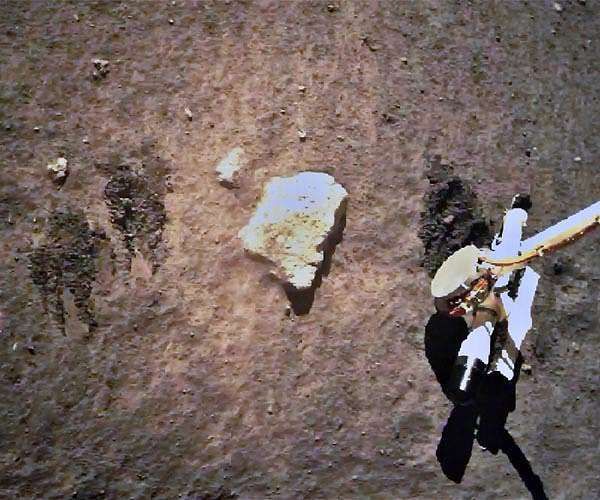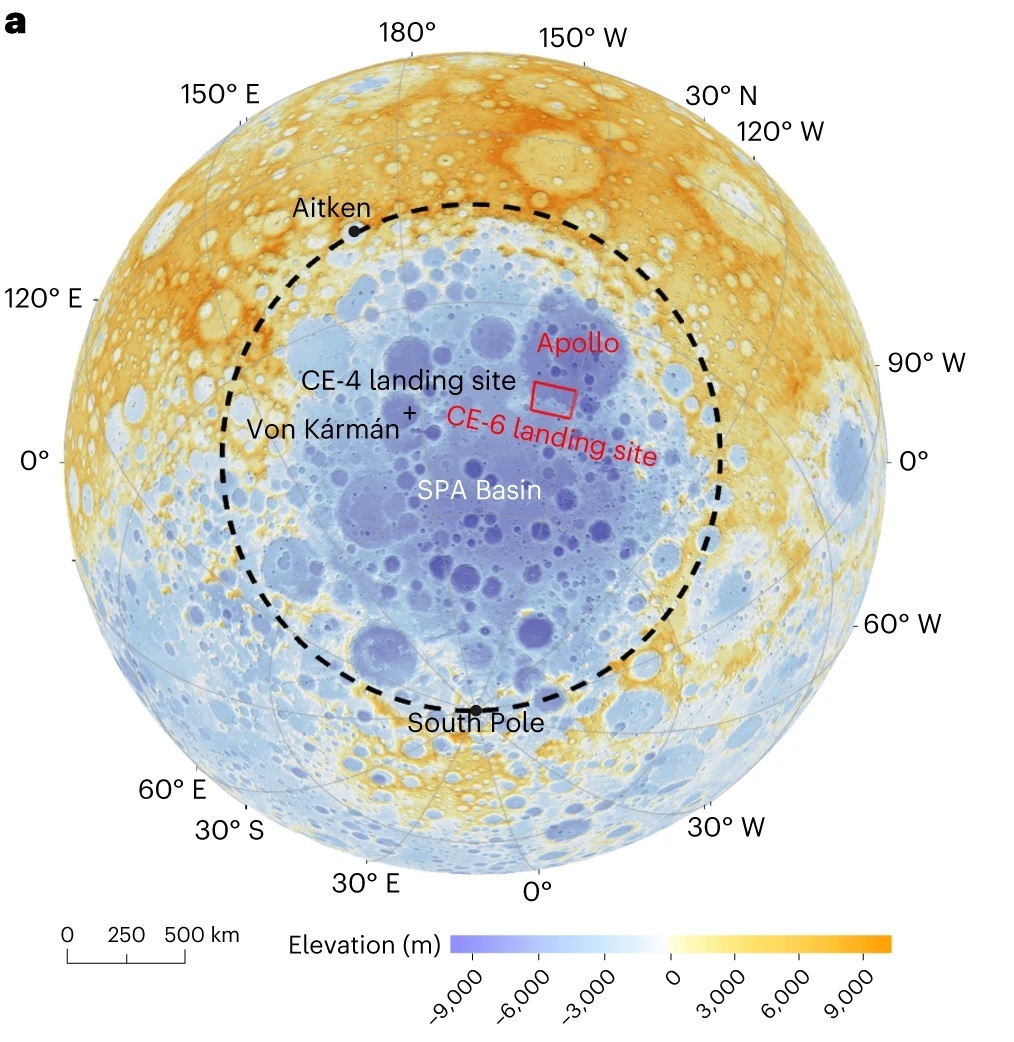3.10.2023
Chang'e 6 scheduled for lunar landing next year

File image of Chang'e 5 collecting samples from the lunar surface for return to Earth.
The Chang'e 6 mission, China's next robotic expedition to the moon, has been scheduled to land on the moon next year, tasked with bringing back samples from the little-known far side, according to the China National Space Administration.
So far, the Chang'e 6 project has progressed smoothly and according to plan, the administration said in a news release on Friday.
To facilitate communications between the Chang'e 6 probe and Earth, a new relay satellite named Queqiao 2 is set to be deployed in lunar orbit in the first half of 2024, it noted.
The Chang'e 6 spacecraft will consist of four components - an orbiter, lander, ascender and re-entry module.
Hu Hao, a senior planner at the administration in charge of the Chang'e 6 mission, said that if everything goes according to plan, the spacecraft will touch down in the South Pole-Aitken Basin and collect dust and rock samples there.
Hu said if the mission succeeds, it would be the first time samples have been collected from the far side of the moon.
"Such samples will enable scientists to advance their studies about the far side. Researchers will also be able to analyze the samples' composition to broaden knowledge about the moon," Hu said.
In addition, the administration has offered to carry a total of 10 kilograms of foreign equipment in the mission's lander and orbiter.
After rounds of selection and talks, it decided that the Chang'e 6's lander will carry scientific instruments from France, Italy and the European Space Agency, and a Pakistani payload will be mounted on the orbiter, according to the planner.
So far, the United States, the former Soviet Union and China have brought lunar substances back to Earth, but none of them has ever obtained samples from the far side.
Tidal forces on Earth slow the moon's rotation to the point where the same side always faces the planet. The other side, most of which is never visible from Earth, is the moon's far side. Although the far side had been extensively photographed by spacecraft, starting with a Soviet probe in 1959, no probe had ever touched down on it until China's Chang'e 4 mission soft-landed in the Von Karman crater in the South Pole-Aitken Basin in January 2019.
China started its lunar program in 2004 and has launched five robotic probes since 2007. The most recent mission, Chang'e 5, landed on the moon in December 2020 and soon returned 1,731 grams of lunar rocks and soil back to Earth, achieving a historic accomplishment about 44 years after the last lunar substances were brought back from our nearest celestial neighbor.
Space program officials said that the substances brought back by the Chang'e 5 probe have helped scientists find out that there was volcanic activity on the moon's near side around 2 billion years ago, and materials from the far side will allow them to verify the hypothesis that volcanoes became inactive about 4 billion years ago on the far side.
In addition, the rover in the Chang'e 4 mission, Yutu 2, has been working there for nearly five years as the longest-operating lunar rover.
Quelle: SD
----
Update: 11.01.2024
.
China says it will launch its next lunar explorer in the first half of this year
China’s space agency says its latest lunar explorer has arrived at the launch site in preparation for a mission to the moon in the first half of this year
BEIJING -- China's space agency said Wednesday that its latest lunar explorer had arrived at the launch site in preparation for a mission to the moon in the first half of this year.
State broadcaster CCTV posted photos on its website of the unit under wraps as it was unloaded from a large cargo airplane earlier this week and then transported by flatbed truck to the Wenchang launch site on southern China's Hainan island.
The announcement came a day after a U.S. company abandoned a lunar landing planned for Feb. 23 because of a fuel leak that started soon after takeoff on Monday.
China and the U.S. are both pursuing plans to land astronauts on the moon in what has become a growing rivalry in space. The U.S. plans to do so in 2026, and China's target date is before 2030.
The China National Space Administration said that pre-launch tests would be carried out on its Chang'e-6 probe. The mission's goals include bringing back samples from the far side of the moon.
Another U.S. moon lander from a Houston company is due to launch next month.
Four countries — the U.S., Russia, China and India — have landed spacecraft on the moon. Only the United States has previously put astronauts on the moon.
Quelle: abcNews
+++
China's Chang'e-6 scheduled for launch in first half of 2024
China's Chang'e-6 lunar probe is scheduled for launch in the first half of this year, the China National Space Administration said Wednesday.
Components for the Chang'e-6 lunar probe have been transported to the Wenchang Spacecraft Launch Site in the southern province of Hainan, and pre-launch tests will be carried out as scheduled, the agency said.
Currently, the facilities at the launch site are in good condition and preparatory work is underway as planned, it added.
The Chang'e-6 is set to collect samples from the far side of the moon, marking a mission that will be the first of its kind in human history.
The mission is poised to make breakthroughs in key technologies, such as automatic sample collection, take-off and ascent from the far side of the moon. Meanwhile, the probe will carry out scientific exploration of the landing zone.
The CNSA has announced that scientific instruments from France, Italy and the European Space Agency/Sweden will be onboard the lander of the Chang'e-6 mission, and a Pakistani payload on the orbiter.
Quelle: Xinhua
----
Update: 12.01.2024
.
China’s Chang’e-6 probe arrives at spaceport for first-ever lunar far side sample mission

A map of the lunar far side, indicating the Chang’e-6 landing zone within Apollo crater. Credit: CNSA
HELSINKI — Components for China’s Chang’e-6 lunar far side sample return mission spacecraft arrived at Wenchang spaceport Wednesday.
The delivery is part of preparations to launch a stack of four spacecraft to land on the far side of the moon, collect samples and deliver them to Earth. The 8,200-kilogram probe will launch on a Long March 5 rocket around May this year.
The spacecraft components were delivered to Hainan island via Antonov An-124 and Xi’an Y-20 transport planes, the China National Space Administration (CNSA) announced Jan. 10. These were then transferred to Wenchang Satellite Launch Center. Assembly and testing will begin in the near future.
CNSA stated the mission will launch within the first half of 2024. Earlier indications suggest the Chang’e-6 will launch around May.
Chang’e-6 is a follow up to the 2020 Chang’e-5 mission which collected 1,731 grams of lunar material from Oceanus Procellarum on the near side of the moon.
The new and more ambitious mission will require the support of a relay satellite known as Queqiao-2 (“Magpie Bridge-2”). This is because the far side of the moon never faces Earth due to tidal locking, making direct communication with that lunar hemisphere impossible.
Queqiao-2 is expected to launch from Wenchang on a Long March 8 rocket in the coming months. Its planned 24-hour-period, elliptical frozen orbit will take it out beyond the moon, from which it will have line of sight with both ground stations on Earth and Apollo crater on the lunar far side.
Chang’e-6 will subsequently launch and target a landing in a southern portion of Apollo crater, located at 150–158 degrees west, 41–45 degrees south. Apollo lies within the South Pole-Aitken (SPA) basin, a gigantic, ancient impact basin. The lander will attempt to collect 2,000 grams of material, both scooped from the surface and collected by a drill.
An ascent vehicle will send a canister of collected samples back into lunar orbit for rendezvous and docking with the service module. The service module will then return to Earth. Just before arrival it will release a reentry module designed to protect the samples during a high-speed atmospheric reentry.
It is thought that material from beneath the moon’s crust is accessible in the SPA basin. Analysis of such material could provide new insights into the history of the moon and by extension the Earth and wider solar system. It could also help explain why there is a difference in composition of nearside versus far side lunar rock.
The mission is expected to last 53 days from launch till landing, according to China’s Deep Space Exploration Laboratory (DSEL). Chang’e-5 was a 23-day mission.
International participation, future moon base
Chang’e-6 will also carry international payloads. France is providing the Detection of Outgassing RadoN (DORN) instrument which will detect radon outgassing from the lunar crust. Sweden, with ESA support, will contribute the Negative Ions at the Lunar Surface (NILS) payload.
An Italian passive laser retro-reflector will also be aboard. The ICUBE-Q cubesat for Pakistan is also part of the mission.
Samples collected by Chang’e-6 will initially be available to Chinese scientists and institutions before being opened to research proposals internationally.
CNSA made the Chang’e-5 material open to applications from international scientists in August 2023, nearly three years after the return of the spacecraft. NASA-funded researchers were granted permission to apply for access to the samples in late November, despite Congressional barriers to bilateral activities with Chinese entities.
The only previous soft landing on the lunar far side was made by China’s Chang’e-4. That lander and rover mission set down in Von Kármán crater in early 2019. That mission was supported by a first Queqiao satellite. Both spacecraft were stated to still be operational early this year, though China provides few updates on the mission.
The Chang’e-5 and 6 missions can also be seen as miniature test missions for getting astronauts onto the moon and safely back to Earth. China has recently stated it intends to put a pair of astronauts on the moon before 2030.
Chang’e-6 is also nominally part of the China-led International Lunar Research Station (ILRS) program. The aim of the project is to establish a permanent lunar base in the 2030s. Like the U.S. and its Artemis program, China is attempting to attract partners for the ILRS initiative.
As of early December 2023, eight countries—China, Russia, Venezuela, Belarus, South Africa, Azerbaijan, Pakistan and Egypt—had signed up to the ILRS. A handful of inter-governmental organizations, firms, universities and other entities have also joined.
The first steps to establishing an ILRS robotic moon base are the Chang’e-7 and 8 south polar missions. These are scheduled for 2026 and 2028 respectively. Both China and NASA are interested in overlapping areas at the lunar south pole. The ILRS will be constructed using super heavy-lift rocket launches in the 2030s.
Quelle: SN
